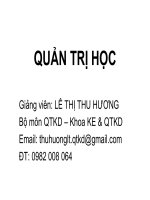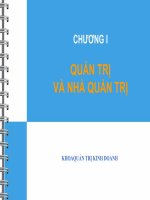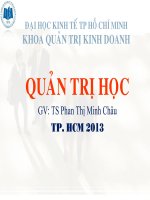Bài giảng môn Quản trị học Chương 14
Bạn đang xem bản rút gọn của tài liệu. Xem và tải ngay bản đầy đủ của tài liệu tại đây (1018.42 KB, 29 trang )
14
Chapter
Foundations
of Control
© Pearson Education Limited 2015
14-1
Learning Outcomes
• Explain the nature and importance of control.
• Describe the three steps in the control process.
• Discuss the types of controls organizations and
managers use.
• Discuss contemporary issues in control.
© Pearson Education Limited 2015
14-2
14.1
Explain the nature
and importance of
control.
© Pearson Education Limited 2015
14-3
The Communication Process
© Pearson Education Limited 2015
14-4
The Importance of Control
© Pearson Education Limited 2015
14-5
14.2
Describe the three
steps in the control
process.
© Pearson Education Limited 2015
14-6
The Control Process
© Pearson Education Limited 2015
14-7
Measuring Performance
Sources of information:
• Personal observation
• Statistical reports
• Oral reports
• Written reports
© Pearson Education Limited 2015
14-8
Criteria for Measurement
What managers measure is probably more important to the
control process than how they measure.
© Pearson Education Limited 2015
14-9
Range of Variation
© Pearson Education Limited 2015
14-10
Comparing Performance to Goals
© Pearson Education Limited 2015
14-11
Correcting Performance
• Immediate corrective action
• Basic correction action
© Pearson Education Limited 2015
14-12
Revising Standards
If performance consistently exceeds the goal,
then the goal may need to be raised.
© Pearson Education Limited 2015
14-13
14.3
Discuss the types
of controls
organizations and
managers use.
© Pearson Education Limited 2015
14-14
Feedward Control
© Pearson Education Limited 2015
14-15
Concurrent Control
Control that takes place while a work activity
is in progress.
© Pearson Education Limited 2015
14-16
Feedback Control
Control that takes place after a work activity is
done.
© Pearson Education Limited 2015
14-17
Keeping Track of an Organization’s
Finances: Ratio Analysis
© Pearson Education Limited 2015
14-18
Keeping Track of an Organization’s
Finances: Budget Analysis
Budgets are used for both planning and
controlling.
© Pearson Education Limited 2015
14-19
Keeping Track of an Organization's
Information
Management information system (MIS):
A system used to provide management with
needed information on a regular basis.
© Pearson Education Limited 2015
14-20
Keeping Track of Employee
Performance
© Pearson Education Limited 2015
14-21
Keeping Track with a Balanced
Scorecard Approach
•
•
•
•
Financial
Customer
Internal Processes
People/innovation/growth assets
© Pearson Education Limited 2015
14-22
14.4
Discuss
contemporary
issues in control.
© Pearson Education Limited 2015
14-23
Contemporary Issues
1. Cross-cultural differences
2. Workplace concerns
© Pearson Education Limited 2015
14-24
Cultural Differences
© Pearson Education Limited 2015
14-25









